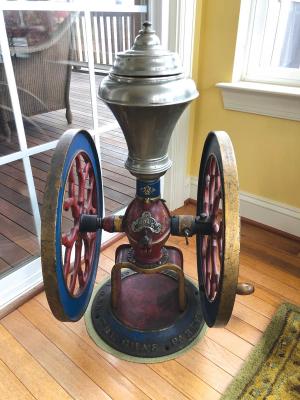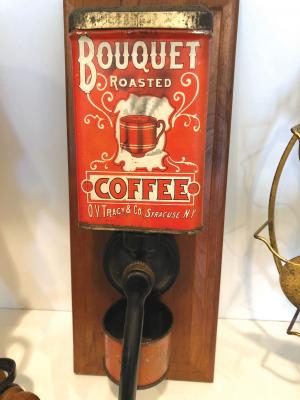Coffee Mills Are Beautiful, Easy To Collect
The working parts of a coffee mill are pretty basic - two metal plates that grind against each other. But the shapes and styles of the housing they are contained in seem to be limitless. With everything from plain boxes to artistically embossed cast iron bodies and handles, the thousands of models make coffee mills very collectable.
Collector Shane Branchcomb started innocently enough figuring he’d add a few coffee grinders to his kitchen collectables. Now his 650+ coffee mills surpass his other collections, and he is president of the Association of Coffee Mill Enthusiasts (ACME).
“I collect anything that meets my fancy,” he says. “Nothing made after 1950, generally. Mostly late 1800’s and early 1900’s.”
There are plenty of options with everyone from small town blacksmiths to small and large manufacturers creating their own versions of the once must-have appliance. The Charles Parker Co., famous for its shotguns and anvils; Griswold known for cast iron pans; and even Peugeot, the French car maker, all produced coffee mills.
There are tiny ones to grind just enough coffee for individuals and there are 6-ft. floor models that weigh 400 lbs.
“The largest one I have is 40 in. tall and weighs 190 lbs.,” Branchcomb says. “Quite a few of them still work, but some are very worn.”
They don’t grind coffee fine enough to make the strong coffee people prefer today, he notes. The grounds are more suited for percolators or boiling on the stove.
However, today’s obsession for coffee and coffee shops seem to have insprired interest in collecting the mills. eBay and other auction sites offer many options. Enterprise, Bronson & Walton and Arcade are common companies, and folks who want to decorate with an old coffee mill can find something attractive for as little as $50 to $100. Highly desirable and scarce pieces can run $2,000 to $3,000.
Manufacturing names can usually be found embossed on the handle of cast iron models or on labels or engraved on handles of wooden box mills. You can tell an original box mill by its dovetail or machine-cut finger joints, he adds. Collectors pay attention to details like that to avoid reproductions, which often have plastic parts.
For folks who find an old coffee mill in their home, Branchcomb suggests they go to ACME’s website to check out photos and contact members for information.
It’s possible they may have a coffee mill or grist mill that a collector wants.
For example, there is a photograph of a patented coffee mill thought to be made in Newton, Iowa.
“No one has ever seen one, so does one exist?” Branchcomb questions. “Anyone can collect coffee mills and you don’t have to spend a lot of money to build a sizable collection. It’s a fun hobby to be in, but people need to do their homework.”
Contact: FARM SHOW Followup, ACME, P.O. Box 64, Loveland, Ohio 45140 (ph 703 209-0877; www.antiquecoffeegrinders.net; acmeman1@verizon.net; millaholics@antiquecoffeegrinders.net).

Click here to download page story appeared in.
Click here to read entire issue
Coffee Mills Are Beautiful Easy To Collect FARM HOME Miscellaneous The working parts of a coffee mill are pretty basic - two metal plates that grind against each other But the shapes and styles of the housing they are contained in seem to be limitless With everything from plain boxes to artistically embossed cast iron bodies and handles the thousands of models make coffee mills very collectable Collector Shane Branchcomb started innocently enough figuring he’d add a few coffee grinders to his kitchen collectables Now his 650+ coffee mills surpass his other collections and he is president of the Association of Coffee Mill Enthusiasts ACME “I collect anything that meets my fancy ” he says “Nothing made after 1950 generally Mostly late 1800’s and early 1900’s ” There are plenty of options with everyone from small town blacksmiths to small and large manufacturers creating their own versions of the once must-have appliance The Charles Parker Co famous for its shotguns and anvils; Griswold known for cast iron pans; and even Peugeot the French car maker all produced coffee mills There are tiny ones to grind just enough coffee for individuals and there are 6-ft floor models that weigh 400 lbs “The largest one I have is 40 in tall and weighs 190 lbs ” Branchcomb says “Quite a few of them still work but some are very worn ” They don’t grind coffee fine enough to make the strong coffee people prefer today he notes The grounds are more suited for percolators or boiling on the stove However today’s obsession for coffee and coffee shops seem to have insprired interest in collecting the mills eBay and other auction sites offer many options Enterprise Bronson & Walton and Arcade are common companies and folks who want to decorate with an old coffee mill can find something attractive for as little as $50 to $100 Highly desirable and scarce pieces can run $2 000 to $3 000 Manufacturing names can usually be found embossed on the handle of cast iron models or on labels or engraved on handles of wooden box mills You can tell an original box mill by its dovetail or machine-cut finger joints he adds Collectors pay attention to details like that to avoid reproductions which often have plastic parts For folks who find an old coffee mill in their home Branchcomb suggests they go to ACME’s website to check out photos and contact members for information It’s possible they may have a coffee mill or grist mill that a collector wants For example there is a photograph of a patented coffee mill thought to be made in Newton Iowa “No one has ever seen one so does one exist?” Branchcomb questions “Anyone can collect coffee mills and you don’t have to spend a lot of money to build a sizable collection It’s a fun hobby to be in but people need to do their homework ” Contact: FARM SHOW Followup ACME P O Box 64 Loveland Ohio 45140 ph 703 209-0877; www antiquecoffeegrinders net; acmeman1@verizon net; millaholics@antiquecoffeegrinders net
To read the rest of this story, download this issue below or click
here to register with your account number.








